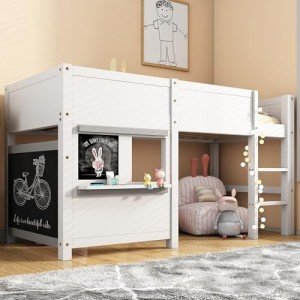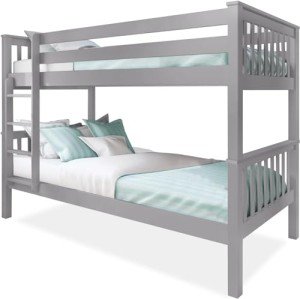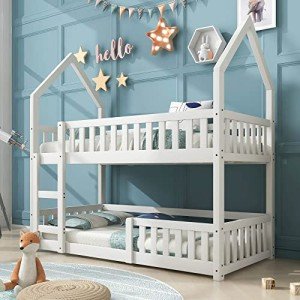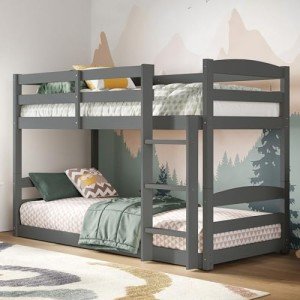When it comes to designing a child's bedroom, parents often find themselves navigating a myriad of choices that balance aesthetics, functionality, and safety. Among the plethora of options available in the furniture market, white twin bunk beds with a ladder and a whimsical castle design stand out as an enchanting solution. These beds not only amplify the room's aesthetic appeal but also spark imagination and creativity in children.
Aesthetic Appeal and Versatility
White twin bunk beds with a castle design bring a touch of whimsy to any child's room. The clean, bright finish of white paint creates a feeling of spaciousness and freshness, making it an ideal choice for small rooms. The castle design adds a fairy tale element, turning an ordinary sleeping space into a dreamy kingdom.
Key Features of White Twin Bunk Beds
-
Design Versatility: The neutral color and fantastical design work well with various décor themes, whether contemporary, traditional, or a mix of both. They can seamlessly integrate into bedrooms decorated with pastel colors, vibrant prints, or even minimalist aesthetics.
-
Space Efficiency: Twin bunk beds maximize floor space, allowing for additional furniture or play areas. This feature is particularly important in smaller rooms where every square foot counts.
-
Imaginative Play: The castle theme inspires imaginative play. Children can turn bedtime into an adventure, igniting their creativity as they play out stories of knights, princesses, and magical realms.
Functionality: Safety and Practicality
While the aesthetic of a white twin bunk bed with a ladder and castle design captures the imagination, safety and practicality are equally crucial. These beds are designed not only for beauty but also for efficiency and security.
Safety Features
-
Sturdy Construction: Most beds are made from high-quality wood or metal that can support the weight of two children. Reinforced framing ensures durability.
-
Secure Ladder: A sturdy, easy-to-climb ladder is a critical component, often incorporating handrails to aid in safe ascending and descending.
-
Guardrails: For safety, upper bunks should feature guardrails that prevent children from rolling out during sleep. Most designs keep these railings high to ensure maximum protection.
-
Non-slip Steps: Many models come equipped with non-slip steps on the ladder making it safer for kids to climb up and down.
Practical Benefits
-
Storage Solutions: Many designs come accompanied by options for drawers or cubbies beneath the bed, perfect for storing toys, clothes, or bedding, thereby keeping rooms tidy.
-
Easy to Assemble: Most modern designs are user-friendly, allowing for quick and easy assembly without the need for professional assistance.
Considerations for Choosing the Right Bed
Before settling on a white twin bunk bed with ladder and castle design, parents should consider several factors to ensure the best choice for their children's needs:
-
Room Size: Measure the space to confirm that the bed will fit comfortably, leaving room for movement and additional furnishings.
-
Age Appropriateness: Bunk beds are typically recommended for children ages six and up. Assess the children’s readiness for sleeping on the top bunk.
-
Quality and Safety Certifications: Ensure the bed meets safety standards and is made from non-toxic materials.
-
Style Preference: Engage children in the decision-making process, so they feel a sense of ownership over their new sleeping space.
FAQs on White Twin Bunk Beds with Ladder and Castle Design
What age is appropriate for a bunk bed?
Bunk beds are generally suitable for children aged six and older. At this age, children are usually more adept at climbing and descending safely.
How do I ensure the bunk bed is safe?
Choosing a bed with safety features such as guardrails, a sturdy ladder, and a solid construction is essential. Always review assembly instructions and periodically check for any loose screws or components.
Can bunk beds be separated into two single beds?
Many styles of twin bunk beds can be separated into individual beds. This feature can offer versatility as children grow or if their sleeping arrangements change.
What materials are bunk beds commonly made from?
Bunk beds can be constructed from a variety of materials, including solid wood, engineered wood, metal, and a combination of these. Solid wood is often favored for its durability and aesthetic appeal.
How do I maintain a wooden bunk bed?
Regularly check for wear and tear, ensuring joints are secure and wood is not splintered. Dust the bedding and wood surfaces, and occasionally treat the wood with a polish for added care.
White twin bunk beds with a ladder and castle design present an irresistible combination of aesthetic charm, safety, and practicality. Not only do they provide a functional sleeping arrangement that optimizes space, but they also create a magical environment for children to explore their creativity and enjoy their bedrooms to the fullest. As parents assess their options, these enchanting beds will undoubtedly remain a front-runner for transforming a child's room into a whimsical sanctuary fit for every young dreamer. With careful consideration of the child's needs and room specifications, these beds can play a crucial role in enhancing both bedroom functionality and imaginative play.






